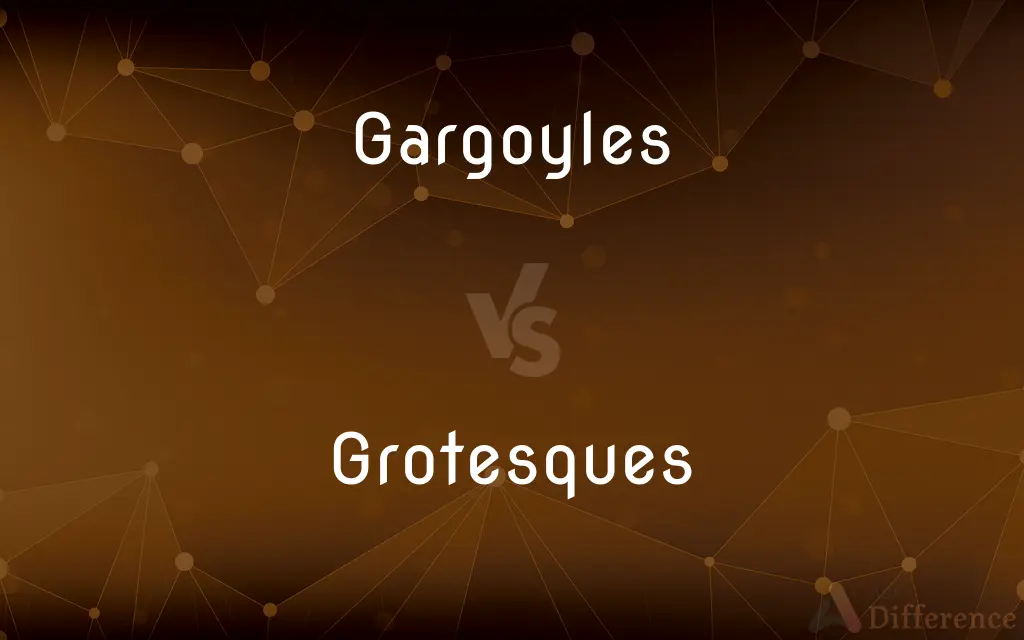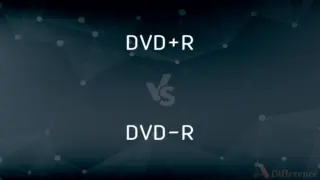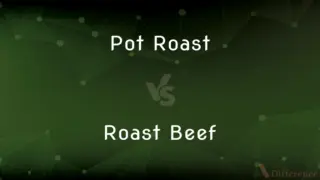Gargoyles vs. Grotesques — What's the Difference?
Edited by Tayyaba Rehman — By Fiza Rafique — Published on December 5, 2023
Gargoyles are carved stone creatures with a spout designed to convey water from a roof, while grotesques are decorative stone figures without a functional purpose.

Difference Between Gargoyles and Grotesques
Table of Contents
ADVERTISEMENT
Key Differences
Gargoyles are primarily known for their functional purpose in architecture. They are carefully crafted stone or metal spouts allowing rainwater to flow away from a building, ensuring that the stone walls and foundation stay undamaged. On the other hand, grotesques are ornamental, often taking the form of distorted, fantastical creatures, but lacking the specific water-diverting function that gargoyles have.
Historically, both gargoyles and grotesques can be traced back to ancient civilizations. Gargoyles, with their water-draining function, were seen on ancient Egyptian temples and Greek temples. Grotesques, while also ancient, primarily serve as decorative elements, making them distinct from the functional aspects of gargoyles.
In medieval times, gargoyles were often designed as mythical creatures or beasts, which were believed to ward off evil spirits and protect the buildings and their inhabitants. Meanwhile, grotesques, due to their decorative nature, were representations of unimaginable creatures, often amalgamations of different animals, reflecting the artists' creativity.
Both gargoyles and grotesques can be seen in Gothic architecture, adorning many cathedrals and historic buildings. Gargoyles, with their protruding designs, serve as water spouts, directing rainwater away. Grotesques, on the other hand, were carved more for aesthetic appeal, enhancing the building's overall artistic design.
It's essential to understand that all gargoyles can be classified as grotesques due to their ornate and often monstrous designs. However, not all grotesques are gargoyles since they lack the water-conveying functionality.
ADVERTISEMENT
Comparison Chart
Functionality
Serve as water spouts
Purely decorative
Historical Origin
Found in ancient Egyptian and Greek architecture
Ancient, but more prevalent in medieval structures
Design
Often mythical creatures
Distorted, fantastical creatures
Usage in Architecture
Common in Gothic cathedrals
Also present in Gothic designs
Key Feature
Has a spout for water drainage
No functional spout, only decorative
Compare with Definitions
Gargoyles
Often resemble mythical creatures or beasts.
The dragon-shaped gargoyles were believed to keep evil at bay.
Grotesques
Decorative stone sculptures on buildings.
Grotesques added an artistic touch to the facade of the mansion.
Gargoyles
Carved stone creatures designed to divert rainwater away from buildings.
The Notre-Dame Cathedral in Paris is adorned with iconic gargoyles.
Grotesques
Ornamental with no drainage function.
Unlike Gargoyles, Grotesques had no channels for water drainage.
Gargoyles
Architectural features with both functional and decorative purposes.
Gargoyles were cleverly integrated into the building's design to prevent erosion.
Grotesques
Can represent various forms, including mythical creatures.
The Grotesques on the library depicted a mix of humans and mythical beings.
Gargoyles
Commonly associated with Gothic architecture.
Many medieval cathedrals used gargoyles as essential architectural elements.
Grotesques
Important elements in Gothic architectural narratives.
The Grotesques contributed to the overall storytelling of the Gothic cathedral.
Gargoyles
A subtype of grotesques with a specific water-draining function.
While all gargoyles are grotesques, not all grotesques serve as water spouts.
Grotesques
Often tell stories or are symbolic.
Many Grotesques on cathedrals convey biblical stories or moral lessons.
Gargoyles
A roof spout usually in the form of a grotesque or fantastic creature projecting from a gutter to carry rainwater clear of the wall.
Grotesques
Characterized by ludicrous, repulsive, or incongruous distortion, as of appearance or manner.
Gargoyles
A grotesque ornamental figure or projection.
Grotesques
Outlandish or bizarre, as in character or appearance.
Gargoyles
A person of bizarre or grotesque appearance.
Grotesques
Of, relating to, or being the grotesque style in art or a work executed in this style.
Gargoyles
Plural of gargoyle
Grotesques
One that is grotesque.
Grotesques
A style of painting, sculpture, and ornamentation in which natural forms and monstrous figures are intertwined in bizarre or fanciful combinations.
Grotesques
A work of art executed in this style.
Grotesques
Plural of grotesque
Common Curiosities
Do Gargoyles always depict scary or monstrous figures?
While Gargoyles are often carved as monstrous figures, they can depict various forms, depending on the artist's intent.
Are Gargoyles and Grotesques the same thing?
No, Gargoyles are functional water spouts, while Grotesques are decorative sculptures.
Can Grotesques be found inside buildings?
Yes, Grotesques can be placed anywhere on or in a building since they're ornamental.
Why are Gargoyles shaped the way they are?
Gargoyles are designed to direct water away, but their artistic design can vary based on aesthetics or symbolic reasons.
Can Grotesques depict cheerful or benign figures?
Yes, while many Grotesques depict strange or monstrous figures, they can also represent cheerful or neutral forms.
Why are some Gargoyles so intricately designed?
Intricate designs can showcase the sculptor's skill, add aesthetic appeal, or convey symbolic messages.
Is there any maintenance required for Gargoyles?
Yes, like other architectural elements, Gargoyles may require cleaning or repairs, especially since they channel water.
Are Grotesques exclusive to Gothic architecture?
While prominent in Gothic architecture, Grotesques can be found in various architectural styles.
Why would a building have Grotesques if they're not functional?
Grotesques serve an artistic or symbolic purpose, contributing to the building's narrative or aesthetic.
How do Gargoyles protect buildings?
Gargoyles direct rainwater away from buildings, preventing erosion and water damage.
Are Gargoyles unique to European architecture?
Gargoyles are most associated with European Gothic cathedrals, but similar water spouts exist in other cultures.
Are all Gargoyles ancient?
While many Gargoyles are on historic buildings, modern architects sometimes incorporate them for aesthetic or nostalgic reasons.
Are Grotesques found in modern architecture?
While more common in historic buildings, modern architects sometimes incorporate Grotesques for artistic or nostalgic reasons.
Were Grotesques ever considered evil or demonic?
Some people historically viewed Grotesques as symbols of evil or paganism, but they often had religious or moral significance.
How do Grotesques contribute to the narrative of a building?
Grotesques can tell stories, represent myths, or convey moral lessons, adding depth to a building's narrative.
Share Your Discovery

Previous Comparison
DVD+R vs. DVD-R
Next Comparison
Pot Roast vs. Roast BeefAuthor Spotlight
Written by
Fiza RafiqueFiza Rafique is a skilled content writer at AskDifference.com, where she meticulously refines and enhances written pieces. Drawing from her vast editorial expertise, Fiza ensures clarity, accuracy, and precision in every article. Passionate about language, she continually seeks to elevate the quality of content for readers worldwide.
Edited by
Tayyaba RehmanTayyaba Rehman is a distinguished writer, currently serving as a primary contributor to askdifference.com. As a researcher in semantics and etymology, Tayyaba's passion for the complexity of languages and their distinctions has found a perfect home on the platform. Tayyaba delves into the intricacies of language, distinguishing between commonly confused words and phrases, thereby providing clarity for readers worldwide.
















































